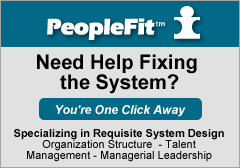Comparing and Contrasting Problem Solving Capability – Continued
By Michelle Malay Carter on June 15, 2010
 As a continuation to my last posts which looked at levels one, two, and three, today we will add level four. Notice how not only does the problem solving pattern change, but also and in parallel, the types of organizational problems addressed at this level are different as well.
As a continuation to my last posts which looked at levels one, two, and three, today we will add level four. Notice how not only does the problem solving pattern change, but also and in parallel, the types of organizational problems addressed at this level are different as well.
Context
The sister truth to the fact that work exists in levels is that human problem solving capability exists in levels as well. Therefore, a level one job will be a best fit for someone who is currently capable of level one problem solving. This reality is a core component of Elliott Jaques’ Requisite Organization model.
How Do Problem Solving Levels Compare?
Level One
I follow procedures and training to create products or deliver services to specification. I make judgments about whether something meets the spec or not. I solve problems only after I encounter them. I work to overcome problems via trial and error.
Level Two
My end product cannot be fully specified. As I work, I accumulate information and add that together to form a hypothesis and make judgments about the best course of action necessary to either head off an impending issue or to correct a current issue.
Level Three
My end product may likely be a process or the implementation of a new or better way. As I work, I must use my judgment to plan and execute at least three serial and contingent steps to get to the end goal. (First I must do A because it will lead to B, which puts me in a position for C) I am no longer solving only today’s issue. I must solve today’s problem while considering and/or moving toward a future state.
Level Four
My end product may now become a system. As I work, I must build comprehensive solutions that balance and integrate multiple serial pathways that are contingent upon one another. I can no longer optimize only my area but rather must work across departments and/or functions. I can no longer focus upon tweaking current operations but rather identify gaps between the five year vision and current operations and systematically bring about entirely new ways, products, markets, clientele, and/or infrastructure to meet the vision.
I’m OK. You’re OK. Let’s fix the system.
Filed Under Requisite Organization
